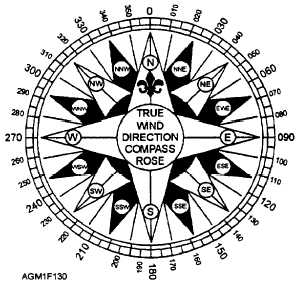Several conventions are used to report wind direction.
As a weather observer, you must be familiar with the
relationship between these direction-reporting
conventions.
Wind Direction Conventions
Wind directions are expressed in azimuth bearings
or by the 8-point or 16-point compass. In addition, the
wind direction may be a true, relative, or a magnetic
wind direction. Wind directions are normally observed
to the nearest 5° of azimuth, but reported (and forecast)
to the nearest 10°.
POINTS OF THE COMPASS.—Points of the
compass as represented in figure 1-30 are normally used
only to express wind directions in general weather
forecasts. They are not used in aviation observations or
forecasts. The standard for expressing wind direction in
most general public weather forecasts and military
forecasts is the 8-point compass. It uses the cardinal
points of the compass (north, east, south, and west) as
well as the inter-cardinal points (northeast, southeast,
southwest, and northwest). General marine area
forecasts may also use intermediate compass points,
such as North-Northeast, East-Northeast, and East-
Southeast. When not specified as "relative" or
"magnetic" directions, the points of the compass refer to
"true" directions.
When wind direction is critical to the safe conduct
of an operation or exercise, such as routine aviation
weather operations, parachute operations, or the
employment of weapons systems, both observed and
forecast wind directions should be provided using
azimuth bearings.
AZIMUTH BEARINGS.—In surface aviation
weather observations, wind direction is always reported
using a 360° azimuth circle with 000°/360°
representing True North. Figure l-30 also shows an
azimuth bearing circle. Note that the 0/360 azimuth
bearing is aligned with True North, the North Pole.
Directions are expressed in degrees of azimuth
progressing clockwise through 090° representing due
East, 180° representing due South, 270° representing
due West, and 360° representing due North. In
meteorology, an azimuth of 000° is used only when no
wind is blowing, while 360° means the wind is from the
North.
True Wind Direction
True North is represented on a globe as the North
Pole. All directions relative to True North may be
called "true bearings." Since the majority of azimuth
bearings for wind directions and navigational bearings
are required to be oriented to True North, a wind
direction or navigational bearing lacking designation is
assumed to be a "true" bearing. A true wind direction is
a wind direction measured with respect to True North.
The wind equipment installed at all shore weather
stations should be oriented to True North. Therefore,
wind direction and wind speed obtained from the
equipment is considered to be a true wind direction and
a true wind speed.
Relative Wind Direction
A relative bearing uses the current direction that an
object (such as a ship or an aircraft) is facing as the
0/360° azimuth alignment. On a ship, a line taken
through the centerline of the ship directly over the bow
represents the relative bearing 0/360°. The relative
azimuth bearings proceed clockwise with directly off
the Starboard Beam representing 090°, dead astern
representing 180°, directly off the Port Beam
representing 270°, and back to the bow at 360°. Wind
direction aboard ship is observed by relative bearing
and is called a relative wind direction. The relative
wind direction (and relative wind speed) may be
manually converted to a true wind direction (and true
wind speed) by using the CP-264/U true wind
computer, a maneuvering board, or an aerological
plotting board.
Do not confuse relative wind with
apparent wind (the relative wind speed with the wind
direction reported using true bearing vice relative
bearings). Apparent winds have no application in
meteorological observations.
Figure 1-30.—Points of the compass and azimuth bearings.
1-43

